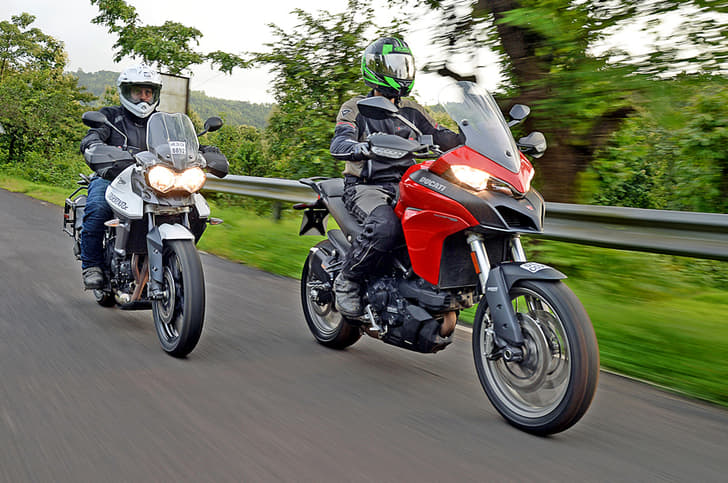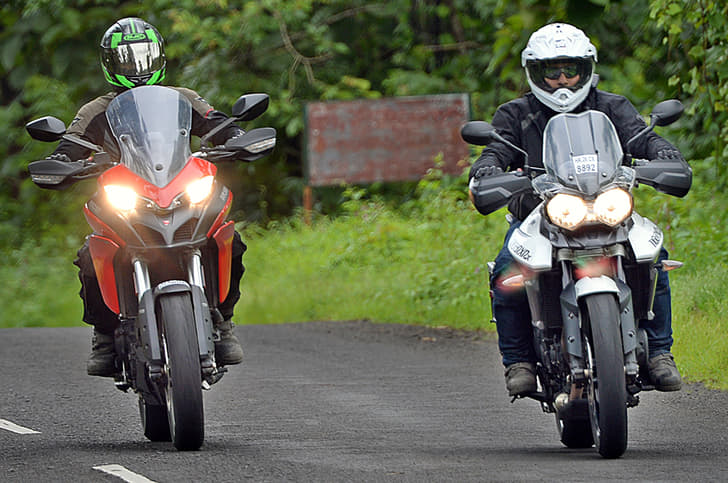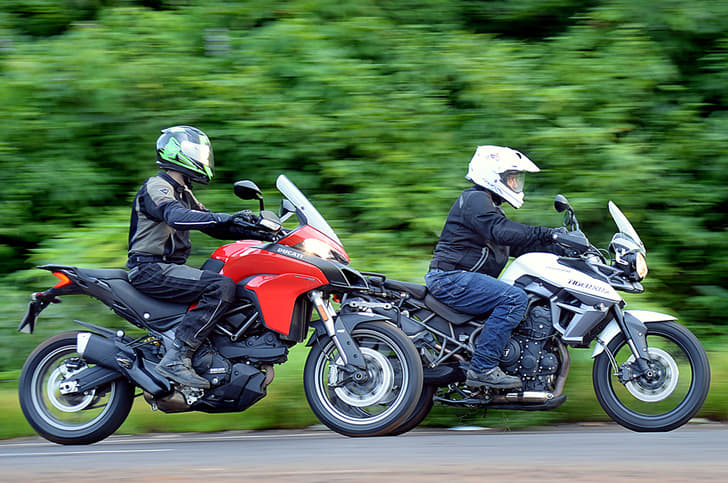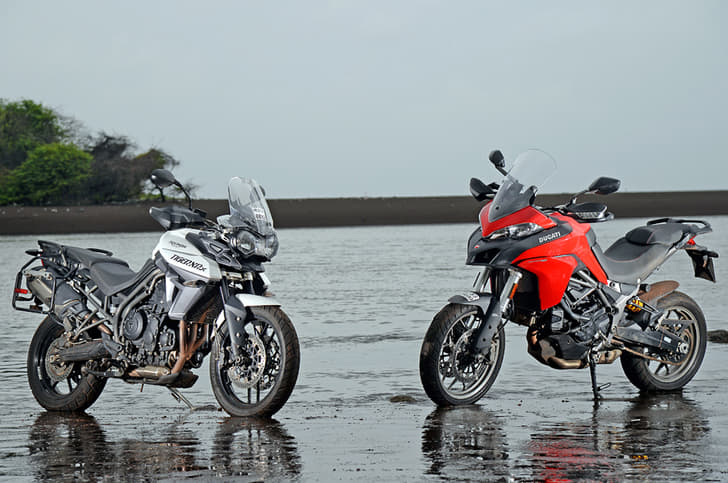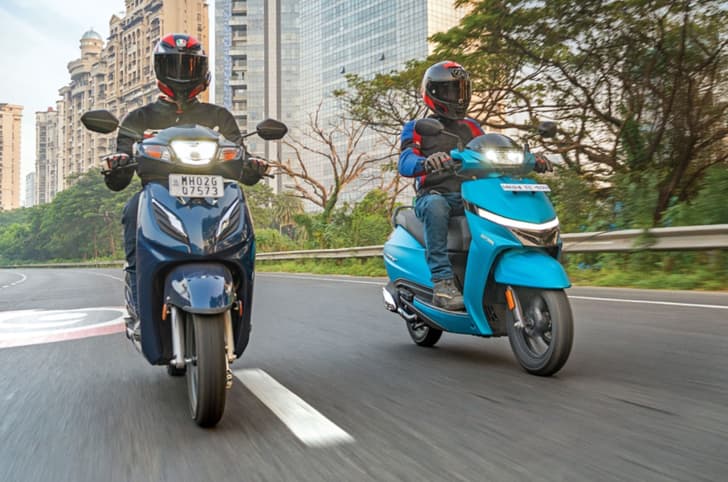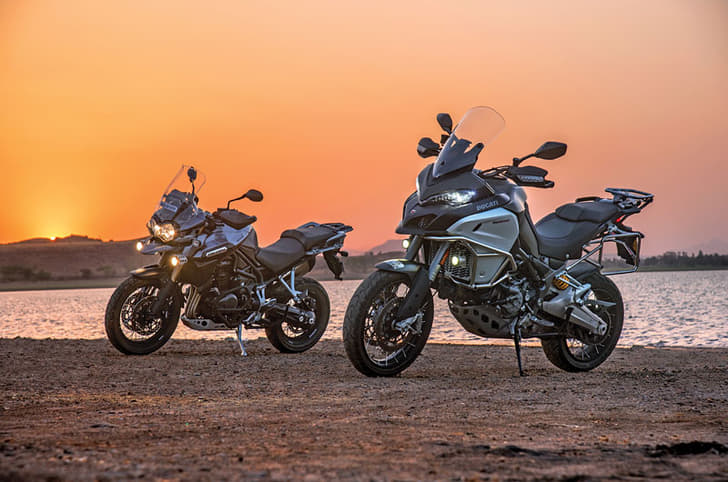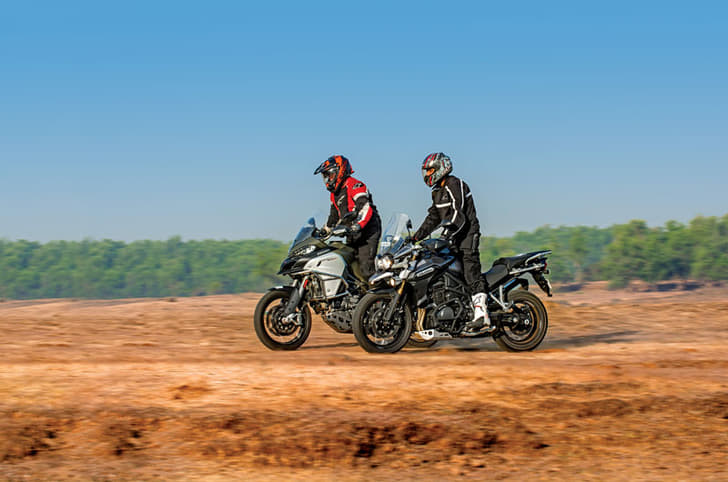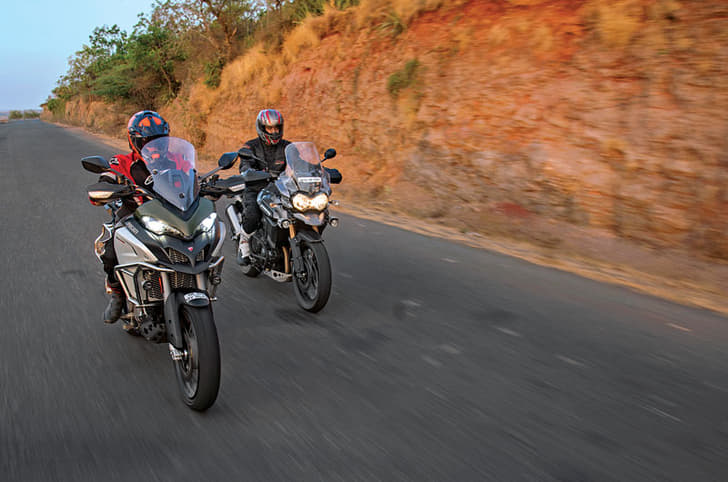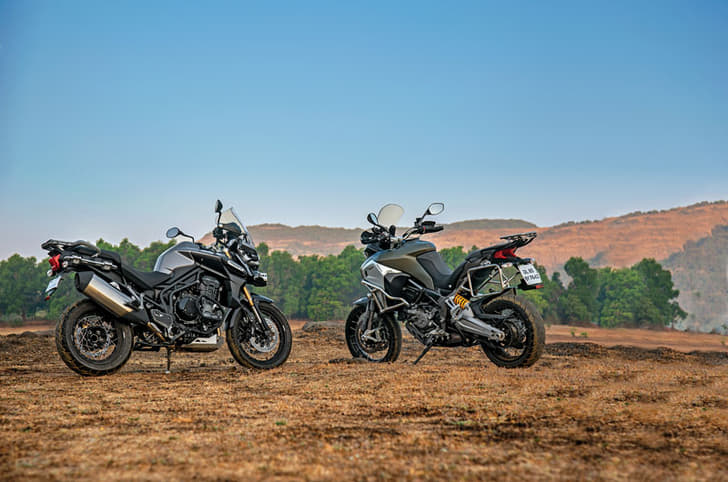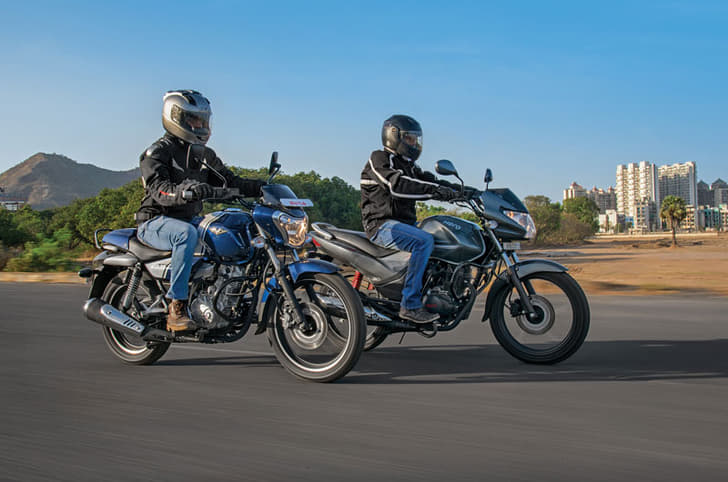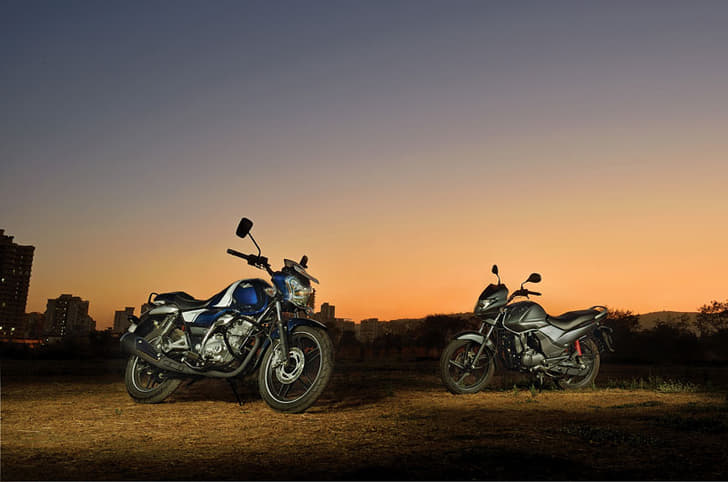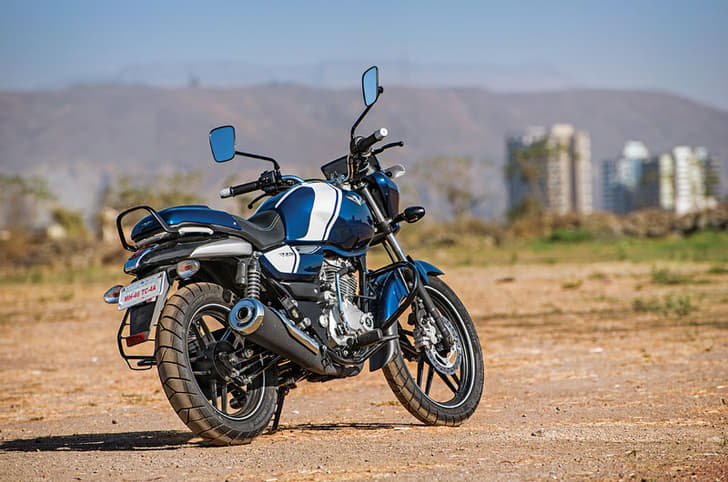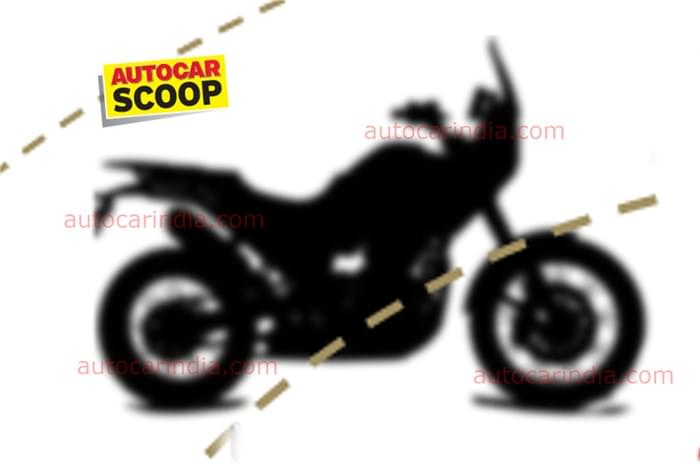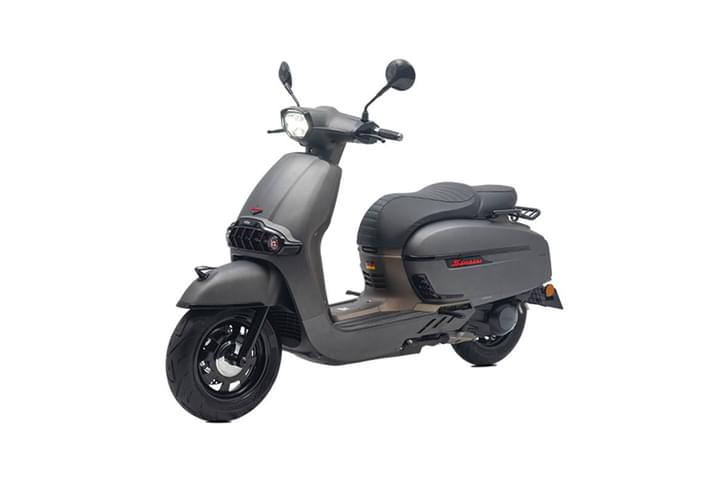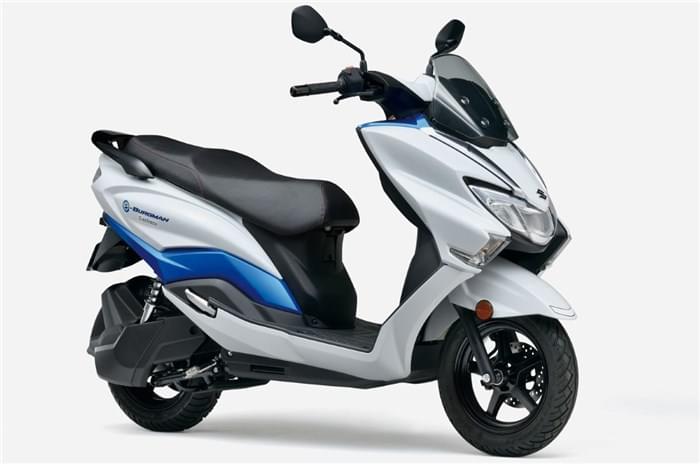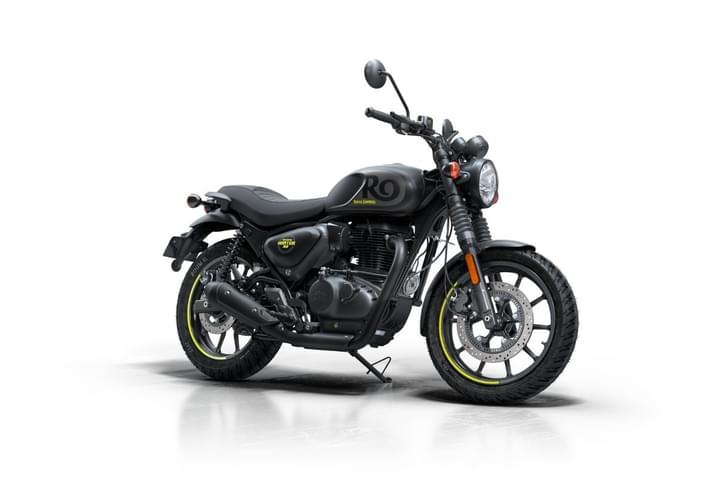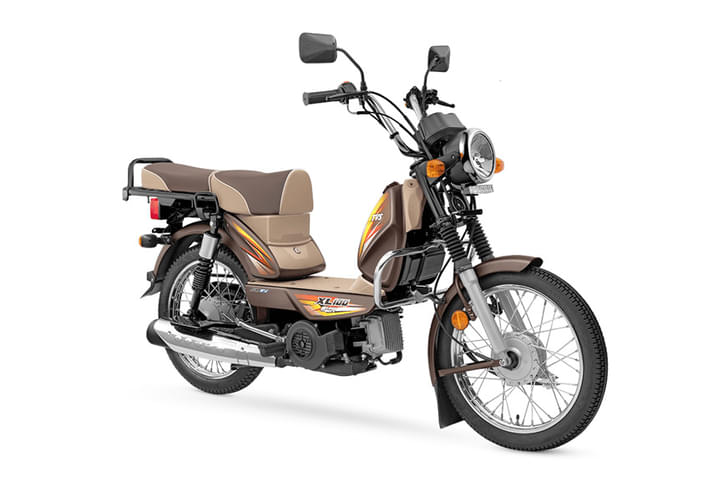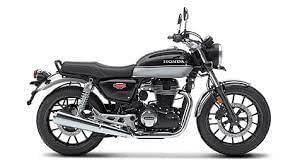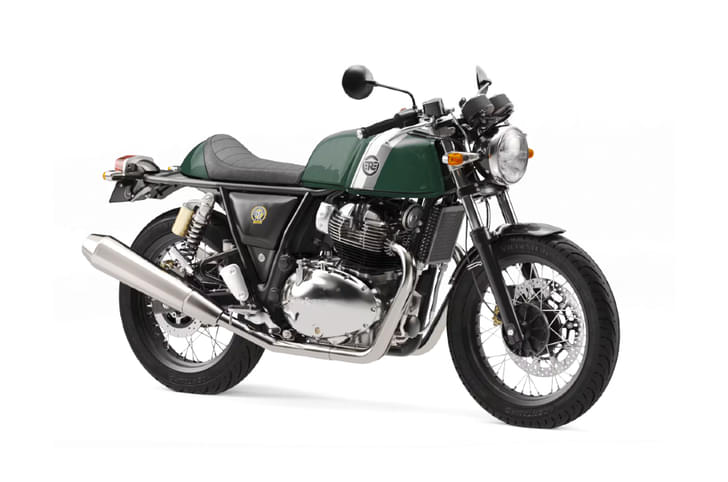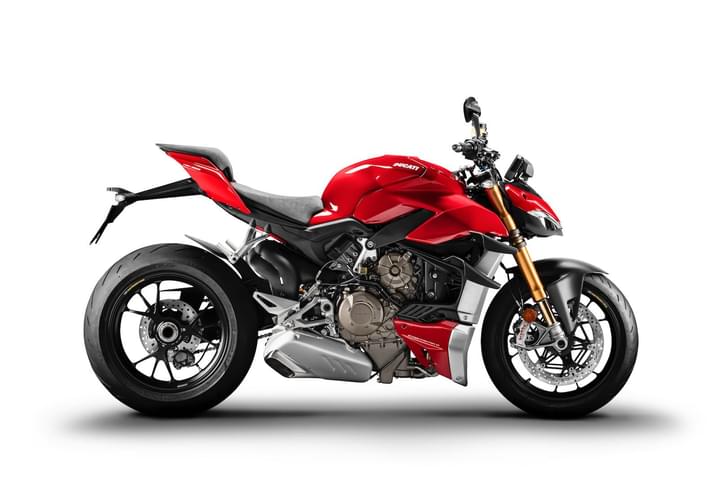The first time I really went touring on a motorcycle in India was well over a decade ago. But I still remember it like it was yesterday. The plan was to cover a (then) seemingly difficult 1,000-odd kilometres in a couple of days on a (now) humble 223cc motorcycle. There was no real concept of riding gear back then, just a decent helmet and a windcheater. There was no concept of motorcycle luggage either, just a duffle bag bungeed down to the back seat. The journey was more arduous than I imagined, but wholly memorable.
I'm astounded about how much things have changed since then as I'm staring down the two motorcycles here, the Triumph Tiger 800 XRx and the Ducati Multistrada 950, as we prepare to get started on a 600km test disguised as a road trip. Back in the day, I couldn't have ever imagined having access to such capable, purpose-built adventure touring machines, and now, this category has practically taken off in India, with the charge led by the Tiger 800. The Multistrada 950, which was launched internationally late last year has finally made its way to India and is looking to take a swing at the Triumph’s dominance in this mid-capacity adventure-tourer space. Time to find out which one really nails the ADV game then.
Judging by the cover
At first glance, both these motorcycles leave very different impressions on you. The Tiger's design looks extremely industrial in nature, like it was sketched with pencil and ruler. Angular lines dominate the bike, with exposed parts on the frame and subframe looking like the scaffolding of a railway bridge – extremely Spartan and functional by nature. Looking at the bike from the front, it actually bears a striking resemblance to WALL-E from Pixar's animated film of the same name. While some might love the unintimidating proportions of the Tiger, many others, who want that ‘big-bike’ look, might loathe it because of its smaller profile, especially from the rear. At the back however, the Tiger does sport a chunky high-mounted exhaust that contributes to a bit of bulk.
The Multistrada on the other hand looks almost organic in nature. The Panigale-style headlights perch over a ‘beak’ that doubles as the air intake, both sitting under a tall fly screen. And the large shrouds flanking the massive radiator give the Multistrada a menacing width. Under all that bodywork hangs a sinewy mass of steel trellis and V-Twin engine, with the back end culminating into a wide(ish) rear seat, wide grab rails and a delectable LED tail-light. And its flat exhaust can is absolutely gorgeous to behold. The Multistrada’s stance appears a lot taller than the Tiger’s and it almost looks like a large bird of prey… one that evolved to hunt big cats. On the whole, it's nearly identical to its larger sibling, the Multistrada 1200, in terms of its design, and that really works wonders for its incredible presence.
Human-machine interface
The Multistrada might look large and intimidating, but swing a leg over and it blows you away with just how slim it feels under you. Yes, the front end of the bike does look bulky from where you're sitting, but the handlebars don't need a big stretch to reach and they're tall and wide enough to provide lots of leverage for turning the bike quickly. In fact, it feels like you're purposely sitting nearer to the front of the bike in order to give you a lot more feedback regarding exactly what the front end is doing. The curved rider’s seat, at 840mm, is not exactly low, but it shouldn't be an issue for anyone who’s of average height or taller. The foot pegs are tall and rear set, almost like a sporty naked, which points to the Multistrada’s intentions as soon as get your feet in place.
The Tiger comparatively feels like a much easier bike when you hop on. Firstly, the seat height is extremely low, at just 810mm (minimum), and you sit slightly farther away from the relatively low set handlebars. The riding posture feels neutral right off the bat, with even the pegs placed in a slightly more forward-set position. But, unlike the Multistrada, you're sitting much farther back on the bike, and that does lend a bit of disconnect from the front end. The rider's seat is a flat affair, which allows for a bit of easier movement back and forth while riding, and the riding position doesn't feel as ‘locked in’ as that of the Multistrada.
Hearts of the beasts
The differences in the way these two motorcycles take on their adventure touring roles become even more apparent when you take a closer look at their powerplants. The Tiger has an 800cc motor, which, in Triumph tradition, is in an inline-three configuration. With 95hp and 78Nm of tap, it isn’t a particularly powerful motor, especially when compared to the Multistrada’s manic 937cc L-twin that it borrows from the Hypermotard. The Ducati enjoys nearly a 20 percent advantage in power and torque figures over the Triumph, making 113hp and 96Nm. Open the taps and the Multistrada pulls with fury and the extra performance over the Tiger is more than noticeable. This Testastretta motor is really punchy past 3,000rpm, but below that it has a tendency to judder when you open the throttle. Slow speed riding needs one to stay in lower gears and even slip the clutch on occasion when the movement comes down to a crawl. No such need on the Tiger. It doesn’t accelerate as if its pants are on fire like the Ducati does, but offers boundless refinement and tractability. Staying in high gears at slow speeds is extremely easy and I found myself keeping the bike in fifth or sixth gear even on city roads. There is excitement to be had once you get the Tiger’s motor revving, but when it comes to thrills, the Multistrada is sure to keep you entertained for much longer.
Both bikes are equipped with six-speed gearboxes, but the Ducati’s gives an impression of operating heavy machinery. Shifts are positive, but the gearbox requires a bit of force to engage. As this motor isn’t as tractable at low revs and the gear ratios are fairly spaced out, you need to shift quite often to keep the Multistrada at its responsive best. The harder shifts and heavier clutch can make this a bit tedious though, especially in heavy traffic. The Tiger’s refinement extends to its gearbox as well. The clutch lever feels lighter and the gearbox shifts with the precise ‘snick-snick-snick’ of a barber’s scissors. Not that you need to shift that much in any case. The closely stacked ratios and the motor’s massive tractability ensure that, out on the highway, you get into sixth very quickly and pretty much just stay there.
Road tripping
The Tiger and the Multistrada have been designed for covering long distances, but each of them goes about doing this in their own unique way. In city traffic, the Tiger feels a lot easier to manage, and while out on the highway, it’s a completely relaxing experience. The 43mm Showa front forks have 180mm of travel while the Showa monoshock at the back gives the rear wheel 170mm of travel. The only adjustability on this suspension is rear preload, and the bike is fairly softly sprung. While this plushness in the suspension makes for a vague feel from the front end when going around corners, it tackles bad roads with utmost ease. The suspension soaks up bumps so well that most times you don’t even need to stand on the pegs when riding on the rough stuff. The Tiger’s Nissin brakes, with twin 308mm front rotors and a single 255mm rear rotor are very capable, and the feel through the lever is good. But their outright stopping power is just about adequate to get the job done, nothing more.
The Multistrada on the other hand is much more firmly sprung out of the box. The 48mm KYB forks are fully adjustable and the Sachs monoshock has remote preload adjustment, so it is possible to get the bike to a setup that works a little better on bad roads. Suspension travel is nearly identical to the Tiger, but it simply doesn’t have the plushness that the Tiger affords. So you need to stand on the foot pegs if you have to ride over broken surfaces with a modicum of comfort. But where it loses out on outright comfort, it more than makes up for in the way it handles the bends. It’s not a light bike by any means, but it changes direction with confidence and the way it hooks up around corners is just phenomenal. And the surge of torque from the motor sends you shooting out of one corner and towards the next at a blistering pace. A “sports bike on stilts” as my colleague Rishaad puts it. Even slowing down is done with poise and confidence, as its Brembo M4.32 radial calipers twin-rotor front brake setup might as well have come straight off a sports bike.
Jungle boogie
Now I don’t claim to be an expert off-road rider, or even a half-decent one at that. Taking two 200-plus kilo adventure bikes off the beaten path isn’t something I’d consider doing, but of these two, if I had to venture out on the loose stuff, I’d pick the Tiger. Even in its road-focused XRx trim, it feels like it’s the easier one to ride on the dirt. It’s over four kilos lighter than the Multistrada (201kg vs 205.7kg), but more importantly, thanks to its low centre of mass, it feels a lot lighter, making it more manageable. The lower seat height means getting your feet on the ground if the bike starts to go down is much easier, and the slimmer tyres are a lot less reactive when off the road. The tractability of the inline-three motor allows for easy throttle management, and that’s exactly what a less experienced dirt rider would want. Much like the Tiger, the Multistrada runs off-road friendly 19-front and 17-inch rear wheel sizes, but still feels a lot more top-heavy and cumbersome on loose surfaces. And even though it has a tighter turning radius as compared to the Tiger, the fact that I couldn’t easily flat-foot the bike made me keep it on tarmac as far as possible. That said, with an expert rider in the saddle, I’m sure the Multistrada will hold its own over unpaved terrain. But I believe the Tiger XRx’s (limited) off-road ability is more accessible.
Electric Avenue
Both these machines offer a bevy of electronic riding aids, but the Ducati really rules the roost in this department. The Multistrada 950 offers an eight-level traction control and a three-level ABS, along with four riding modes – Sport, Touring, Urban and Enduro – which offer varying levels of traction and brake settings. These riding modes also change the response of the ride-by-wire throttle, while the bike also gets a low power mode which drops power output to 75hp to make it more manageable in low-traction or urban conditions. Ducati’s electronics game has been strong, refined over many years on the race track, and the finesse in which the Multistrada’s safety systems work is admirable.
The Tiger too gets a ride-by-wire throttle along with three riding modes – Road, Off-road and Rider – that affect throttle response. The ABS and traction control system are switchable, but that’s it! And to be honest, the Tiger’s traction management feels like an overbearing nanny, not letting the toddler under her care take two steps before she picks it up and puts it back in the crib. Safe for sure, but it can get annoying pretty quick.
Adventure ready?
The Multistrada 950 is quite literally, a more manageable version of its larger sibling, the Multistrada 1200. It doesn’t have quite the oomph of the bigger bike, but it has more than enough poke along with handling prowess to keep you thoroughly entertained on the twisties. Plus it can manage any bad roads it encounters, if it has to. As long as your touring is (mostly) restricted to national or state highways, with the occasional blast over broken roads, this Ducati can be a great companion. The Tiger cannot match the Multistrada for its sharpness in the way it carves up a mountain road. But the moment the roads disappear, the Triumph really shines. It blasts through bad roads, or even no roads, without batting an eyelid, and at the same time makes for a comfortable highway bike as well. It’s a true all-rounder and lives up to its ‘adventure-tourer’ categorisation far better than the Ducati. And at Rs 12.13 lakh (ex-showroom, India), the Tiger XRx is almost Rs 70,000 cheaper than the Multistrada 950 (Rs 12.82 lakh ex-showroom, India) as well, which in our opinion seals the deal in the Triumph’s favour.

